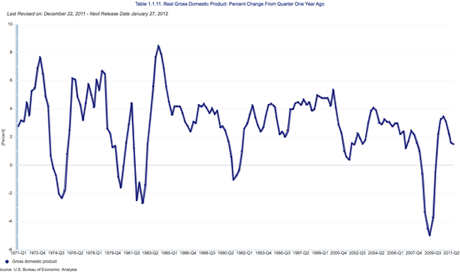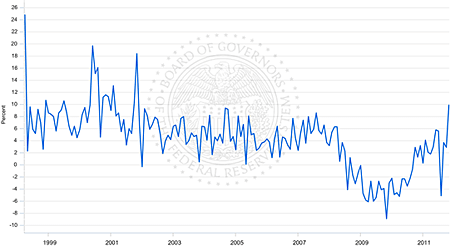Don’t hold your breath for a rampant US recovery
The US economy grew by 2.8% in the last three months of 2011. So are things looking up for the USA or is it a false dawn? Phil Oakley examines the data.
The US economy grew by 2.8% in the last three months of 2011. That was a little worse than expected, but still an improvement on the 1.8% seen in the third quarter.
So are things looking up for the US? Or is it a false dawn? Let's have a look at the data...
Some US companies are becoming more confident
One of the best ways to learn about the economy is to listen to what companies are saying. And if you listen to what construction giant Caterpillar Inc has to say, things are certainly looking up.
MoneyWeek
Subscribe to MoneyWeek today and get your first six magazine issues absolutely FREE

Sign up to Money Morning
Don't miss the latest investment and personal finances news, market analysis, plus money-saving tips with our free twice-daily newsletter
Don't miss the latest investment and personal finances news, market analysis, plus money-saving tips with our free twice-daily newsletter
It reported record sales and profits for 2011, and was also upbeat on the outlook for the US economy in 2012. It expects GDP growth of 3% for the year, and for US construction activity to grow for the first time since 2004.
The company also points out that it should have a big backlog of orders to come. Companies slashed spending on investment during the recession, which has left them with ageing equipment that will need to be replaced. If Caterpillar's expectations are correct, then the US economy will have made a step in the right direction.
Other bulls point to the very strong growth in US consumer credit in November(see below for more), as evidence of US banks being increasingly willing to lend and stimulate economic growth. The jobs market has shown an improving trend in recent months and the unemployment rate has fallen.
But is the US really out of the woods?
Growth is surprisingly weak
Perhaps not. For a start, a growth rate of 2.8% is pretty weak if this is a genuine recovery. During the recovery from the 1980s recession, the US saw quarterly growth rates of more than 8% (see chart below from the Fed).
Annualised US GDP growth

(Click on the chart for a larger version)
Also, these latest GDP figures were heavily boosted by businesses restocking (adding 1.9% to GDP) which does not point to a strong recovery. In other words, companies were rebuilding their inventories. That suggests businesses have been making more goods than they could sell, which could see production slow down in future.
The fact is that the US remains a consumer-driven economy, and there is no hard evidence that US citizens are suddenly going to start spending the amounts of money needed to restore the economy to health retail sales grew by a paltry 0.1% in December.
Some point to increased consumer borrowing (see chart below) as a bullish sign, but it's not a sign of strength. Consumers spending more than they earned is one of the chief reasons America's economy is in trouble: it is not the solution to its problems, nor is it a source of sustainable economic growth.
Percentage growth in US consumer credit

More money printing is on the way
As in Britain, the economic boom in the US was based on flaky foundations. Excess consumer and government borrowing brought forward demand from the future, and is now played out. US companies continue to improve productivity, but are doing so with fewer workers, whilst household disposable incomes are barely matching inflation.
While US consumers have reduced some of their debt (mainly by defaulting on mortgages and other debts), it is still too high. House prices are still falling while the US government still continues to spend more than it takes in (backed up by Ben Bernanke's helpful printing press). Indeed, Mr Bernanke's intentions to keep interest rates at very low levels until 2014 are hardly the actions of a man expecting a return to soaring economic growth.
Sooner or later, the US government will have to take an axe to public spending voluntarily, or the bond market will force it to. This will remove a further source of demand from the economy.
In the meantime, America, like Britain,is left with the largely ineffective policy tools of very low interest rates and money printing. And this latest data suggests that Mr Bernanke might get the opportunity to turn on the presses earlier than he'd expected. Read my colleague John Stepek's Money Morning article for more on how you can profit from this.
Get the latest financial news, insights and expert analysis from our award-winning MoneyWeek team, to help you understand what really matters when it comes to your finances.
Phil spent 13 years as an investment analyst for both stockbroking and fund management companies.
After graduating with a MSc in International Banking, Economics & Finance from Liverpool Business School in 1996, Phil went to work for BWD Rensburg, a Liverpool based investment manager. In 2001, he joined ABN AMRO as a transport analyst. After a brief spell as a food retail analyst, he spent five years with ABN's very successful UK Smaller Companies team where he covered engineering, transport and support services stocks.
In 2007, Phil joined Halbis Capital Management as a European equities analyst. He began writing for MoneyWeek in 2010.
-
 How cancelling unused direct debits could boost your pension by £37,000
How cancelling unused direct debits could boost your pension by £37,000A new year refresh of your spending could save you money and help boost your pension pot.
-
 NS&I cuts interest rates on 8 savings accounts
NS&I cuts interest rates on 8 savings accountsNS&I will now offer less attractive interest rates for customers wishing to lock their savings away to grow for one, two, three or five years.